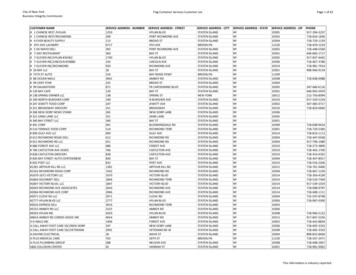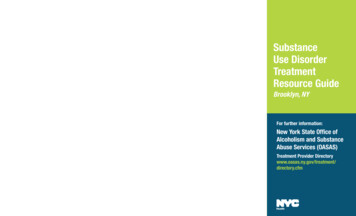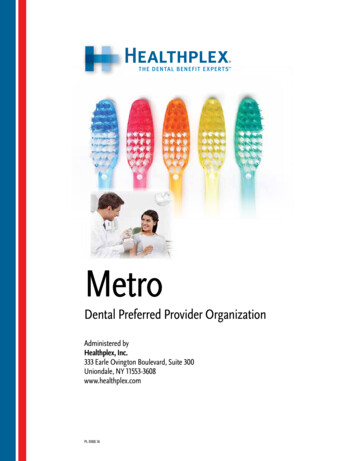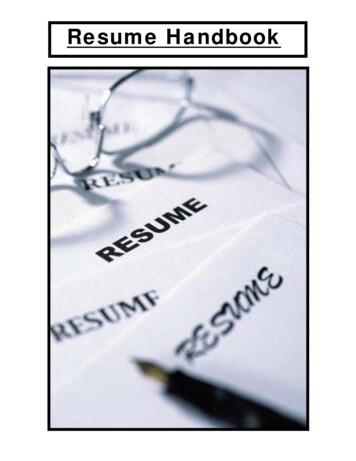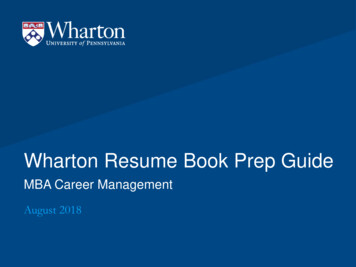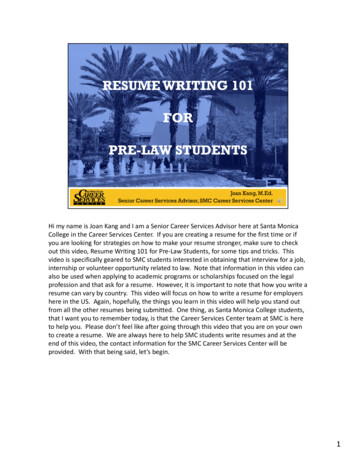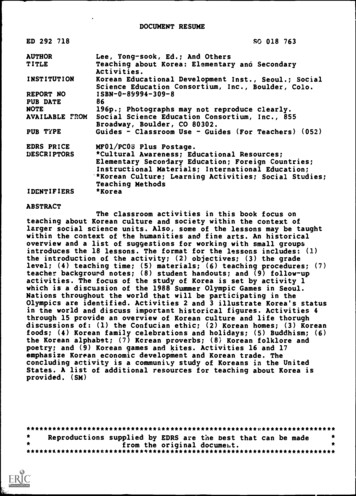
Transcription
DOCUMENT RESUMEED 292 718AUTHORTITLEINSTITUTIONREPORT NOPUB DATENOTEAVAILABLE FROMPUB TYPEEDRS PRICEDESCRIPTORSIDENTIFIERSSO 018 763Lee, Yong-sook, Ed.; And OthersTeaching about Korea: Elementary and SecondaryActivities.Korean Educational Development Inst., Seoul.; SocialScience Education Consortium, Inc., Boulder, Colo.ISBN-0-89994-309-886196p.; Photographs may not reproduce clearly.Social Science Education Consortium, Inc., 855Broadway, Boulder, CO 80302.Guides - Classroom UseGuides (For Teachers) (052)MF01/PC08 Plus Postage.*Cultural Awareness; Educational Resources;Elementary Secondary Education; Foreign Countries;Instructional Materials; International Education;'*Korean Culture; Learning Activities; Social Studies;Teaching Methods*KoreaABSTRACTThe classroom activities in this book focus onteaching about Korean culture and society within the context oflarger social science units. Also, some of the lessons may be taughtwithin the context of the humanities and fine arts. An historicaloverview and a list of suggestions for working with small groupsintroduces the 18 lessons. The format for the lessons includes: (1)the introduction of the activity; (2) objectives; (3) the gradelevel; (4) teaching time; (5) materials; (6) teaching procedures; (7)teacher background notes; (8) student handouts; and (9) follow-upactivities. The focus of the study of Korea is set by activity 1which is a discussion of the 1988 Summer Olympic Games in Seoul.Nations throughout the world that will be participating in theOlympics are identified. Activities 2 and 3 illustrate Korea's statusin the world and discuss important historical figures. Activities 4through 15 provide an overview of Korean culture and life thorughdiscussions of: (1) the Confucian ethic; (2) Korean homes; (3) Koreanfoods; (4) Korean family celebrations and holidays; (5) Buddhism; (6)the Korean alphabet; (7) Korean proverbs; (8) Korean folklore andpoetry; and (9) Korean games and kites. Activities 16 and 17emphasize Korean economic development and Korean trade. Theconcluding activity is a community study of Koreans in the UnitedStates. A list of additional resources for teaching about Korea isprovided. *************************Reproductions supplied by EDRS are the best that can be madefrom the original ******************************
Teaching About KoreaELEMENTARYANDSECONDARYACTIVITIES"DERMISSION TO REPRODUCE TM:,MATERIAL HAS BEEN GRANTED BYCINI.,,,Se-haTO THE EDUCATIONAL RESOURCESINFORMATION CENTER (ERIC)"c)-.9U IS DEPARTMENT Oft .boEDUCATIONOtSce of Educatronal Researchand improvementKorean Educational Development InstituteCoded Science 7dtmatiou Consortium, Inc.EDUCATIONAL RESOURCES INFORMATIONCENTER (ERIC)OThis document has been reprodu-ed lierecervol from the "sown or organizationo.iginatino itValor changes have been made to improve0reproduction Ou SiltyV)Points 01 vie* m Op ions stated in this docirment do not neCessanty represent MeddOERI posh on or policy2
TEACHING ABOUT KOREA:ELEMENTARY AND SECONDARY ACTIVITIESEdited by:Dr. Yong-sook feeKorean Educational Development InstituteJae-taik YooKorean Educational Development InstituteJacquelyn JohnsonSocial Science Education Consortium, Inc.Korean Educational Development InstituteSeoul, KoreaSocial Science Education Consortium, Inc.Boulder, Colo:ado1986
ORDERING INFORMATIONThis publication is available from:Social Science Education Consortium, 1.1c.855 BroadwayBoulder, Colorado 80302ISBN-0-89994-309-8ThistionmentERICpublication will be entered into the Educational Resources InformaCenter (ERIC) system and be available through the Educational DocuReproduction Service (EDRS). Contact a university library or anclearinghouse in your area for ordering information.This publication was prepared with funding from theKorean Educational Development Institute, Seoul,Korea, and the Social Science Education Consortium,Inc.The opinions expressed in this publication doKiSS11111Mnot necessarily reflect the positions or policies ofECKEDI or SSEC.ii
P 4.15.16.17.18.The 1988 Olympics: Harmony and ProgressKorea in The WorldKorean Historical FiguresThe Confucian Ethic: A System of Ideas in KoreaEducation in Korea: A Day in the Life of Korean StudentsKorean HomesKorean Foods: A Reflection of CultureFamily Celebrations and Holidays in KoreaBuddhism in KoreaHan'gul: The Korean AlphabetA Glimpse of Korea through ProverbsKorean FolkloreKorean PoetryYut: A Korean GameKorean KitesMiracle on the Han River: Korean Economic DevelopmentMade in Korea: United States - Korea TradeKoreans in America: A Community StudyADDITIONAL RESOURCES FOR TEACHING ABOUT 217
FOREWORDOver a century has passed since Korea and the United States ofIn the last few decades,America established diplomatic relations.close ties between the two countries have developed in the economic,political, military, and cultural spheres.In recent years, the importance of Korea to the United States has markedly increased as Korea hasbecome the seventh largest American trading partner. Moreover, thenorean community in the United States has rapidly grown in size and status, contributing to the pluralism of cultures.Therefore, it is understandable '-hat Americans' interest in Koreahas grown as Americans have become more aware of Korea's position in theinternational community.However, there are insufficient Englishlanguage resources which can be used in teaching and learning aboutKorea.American social studies textbooks tend to deal with Korea toobriefly, and some of the information in the textbooks is outdated orincorrect. Few additional teaching or learning materials are available.In order to provide American teachers and students with relevantclassroom materials on Korea, this sourcebook of 18 lessons has beendeveloped as a result of the joint effort of the Social Science Education Consortium in Boulder, Colorado. and the Korean Educational Development Institute in Seoul.We hope this sourcebook will help Americans to understand Korea inits true perspective.Young-shik Kim, Ph.D.President, KEDISeoul, KoreaIn the past several years, interest among educators in teachingabout Korea has heightened--largely due to Korea's increasing importancein international trade, Korean immigration to the United States, and theselection of the Republic of Korea as the site of the 1988 Summer Olympic Games. The lessons in this sourcebook represent an internationaleffcrt to provide teachers across the United States with relevant materials on Korea that can be easily integrated into existing K-12 socialstudies programs. The project was conceived by curriculum specialistsat the Korean Educational Development Institute in Seoul and the SocialScience Education Consortium in Boulder, Colorado. The materials weredeveloped with the valuable assistance of classroom teachers and curriculum leaders from across the United States. It is our sincere hope thatthese learning activities will provide teachers a timely tool for teaching about the Korean people and culture.James R. Giese, Ph.D.Executive Director, SSECBoulder, Colorado
ACKNOWLEDGMENTSThis publication represents an international effort in curriculumdevelopment and would not have been possible without the valuable assistance of many individuals and organizations in Korea and the UnitedStates. Approval to compile this publication was given by Dr. Young-shikKim, President of the Korean Educational Development Institute (KEDI),and Dr. Irving Morrissett, Executive Director Emeritus of the SocialScience Education Consortium (SSEC). The project was coordinated inKorea by Dr. Se-ho Shin, Vice President of KEDI, and Dr. Bvong-sun Kwak,Director of the Curriculum Research and Development Department, KEDI,and in the United States by Dr. James R. Giese, Executive Director, SSEC.The research team for this project at KEDI consisted of Mrs. Kun-nimLee, Mr. Jae-taik Yoo, and Dr. Yong-sook Lee, 'Alit of International Comparative Study of Textbooks.The writing team in the United Statesincluded the following classroom teachers and curriculum specialists:Barbara Schubert, E. Robert Scrofani, Pam Newman, Lynn Parisi, Jaye Zola,Cherryl Sage, John Benegar, Aimee Trechock, and Jacquelyn Johnson.Special thanks are also given to Dr. Michael Robinson, Universityof Southern California, for contributing his expertise and valuable support to the project over the past two years; to Tuckie Yirchott, Stanford University, for coordinating curriculum writers on the West Coast;to Laurel Kendall, American Museum of Natural History, for permission touse "Grandmother Kim's Sixtieth Birthday Party", and to Betsy Glade,SSW, and Adelle Meyer, Asia Society, for help with the resource section.The reviewing team at KEDI included the following individuals: Dr.Noh Myeong-wan, Unit of National Language Education; Mrs. Cho Nan-sim,Unit of Moral Education; Mr. Kim Young-joon and Mrs. Baik Eun-soon, Unitof International Comparative Study of Textbooks.The materials werealso reviewed by Dr. Sae-gu Chung, Professor, College of Education,Seoul National University, and Dr. Lee Ki-sang, Assistant Professor,Department of Economics, King Sejong University.The materials werereviewed in the United States by Lynn Parisi, SSEC; Gary Kaasa, ShadowMountain (Arizona) School District; John Benegar, Cherry Creek (Colorado)School District! and Tuckie Yirchott, Stanford (California) Program onInternational and Cross Cultural Education.Finally, special acknowledgment is also given to Cindy Cook, SSECPublications Director, for her hard work in meeting several deadlinesand preparing the final publication; to Reny Sieck and Leslie Hendriksonfor their illustrations; and to Laurel Singleton for editing the finalmanuscript.v:
INTRODUCTIONAlthough Americans have had contact with Korea since the late 19thcentury, widespread consciousness of Korea and Korean culture has on:,recently emerged. Throughout its long history, Korea and its culturehave been overshadowed by its enormous neighbor to the northwest, China.In the 20th century, Korea again took a back seat to American interestin Japan. Our early contacts with Korea were shaped by traders and missionaries. However, for a generation between 1910 and 1945, officialcontact between our governments ceased, as Japan assumed control ofKorean diplomatic relations and subjugated Koreans to their rule.Inthe post-World War II period, Americans returned to Korea, but our contacts with Koreans were flawed by the tragic split of Korea into twospheres as a result of the occupation of divided Korea by the UnitedStates and the U.S.S.R. in 1945 and by the catastrophic Korean Warbetween 1950 and 1953.Korea's unfortunate experience of the 20th century has left alegacy of stereotypes about Korea that belie her long and distinguishedhistory while obscuring a true appreciation of the depth and sophistication of the Korean historical experience. After the American participation in the Sorean War, Korea became better known to the American public, but main1-2 as a poor country in need of he.p.This negative imagelasted long after the Korean War ended, due to its legacy in Korean Warmovies, the M*A*S*H* television series, and the vivid memory of povertyand destruction perceived by many Americans who participated in the war.Only in the past few decades has the relationship between the UnitedStates and the Republic of Korea flowered and the image of Korea amongthe American public improved, fueled by the increasing prominence ofKorea in world trading circles and the dramatic rise of Korean immigration to the United States.In 1986 Korea ranks as our seventh most important trading partner.This ranking is symbolic of Korea's rising prominence in an increasinglyinterdependent world. Korea's per capita gross national product in 1961stood at a meager U.S. 82, near the bottom of the international incomescale. With the economy growing at an average annual rate if 8.6 percent since 1962, per capita GNP in 1984 reached U.S. 2,080 . Exporsrose about 600 times from 55 million in 1962 to 32 billion in 1985 ,due basically to soeling foreign sales of an increasing variety of manufactured goods, including in recent years, microcomputers and automobiles.In addit.,n, the Republic of Korea will host the 1988 OlympicGames in Seoul.Receiving the venue for the 1988 Olympics stands astestimony to Korea's arrival as a full and valued member of the international community. The remarkable rise of the Republic of Korea tointernational prominence in the past few decades and the breathtakingspeed with which the Koreans have transformed their economy and societysince the 1960s have generated tremendous interest worldwide.It isappropriate, therefore, that the subject of Korea and Korean culture1.2.The World Bank Atlas, 1985. Washington, DC:The World Bank, 1985.Korean Economic Yearbook. Seoul: The Federation of Korean Industries, 1986.1
become more prominent in the curriculum of our schools.It is to theexpansion of understanding and appreciation for Korean culture that thematerials featured in this collection are dedicated.The United States has always been a nation of immigrants, and ourculture and society bear the marks of the many different peoples thathave come to our shores. After World War II, a second great migrationof people to the United States began. With changes in the immigrationlaw in 1965, Asians began to occupy an increasingly important positionin this new migration. Today, within the new Asian migration, Koreansrank as the second fastest growing group of new Americans. According tothe 1980 census data, the Korean community in the United States is madeup of 354,543 people.Korea has always been a part of the larger East Asian civilization,and her contributions to this larger civilization have been quite significant. Indeed, it is important to study Korea on her own terms, notas a variant of Chinese civilization, but as a civilization that hasmade important contributions to world culture. Modern Koreans are theproduct of an extraordinarily long process of historical development.The habitation of early men in Korea seems to have started atouthalf a million years ago in the paleolithic period. The first statein Korea, Ancient Choson, was founded in 2333 B.C. by the mythologicalfounder, Tan'gun. Ancient Choson expanded from the southern part ofManchuria to the northern part of the i-orean peninsula.In 108 B.C.,Ancient Choson was overthrown by the Han Empire of China, which established four provincial commanderies in the northern peninsula and Manchuria.Records indicate that the Chinese soon lost their influence in thethree colonies other than Lolang as a result of continuous struggle withneighboring Korean tribal states, especially Puyo and Koguryo.By thefirst century A.D., Koguryo (37 B.C.-A.D. 668) was firmly established asa state power and drove the Chinese colony Lolang out in 313 A.D.While Koguryo clashed frequently with Chinese power in expandingtheir territories, Paekche (18 B.C.-A.D.660) amassed power in the south.The following centuries witnessed the growth of Shilla's (57 B.C.-A.D.935) more fully organized state power.Shilla, with support from the Tang Empire of China, conquereePaekche and Koguryo in 660 and 668 respectively, becoming Unified Shilla(668-935).However, they were unable to dominate Koguryo's Manchurianterritories.A former Koguryo general formed an army of Koguryo andMaigal (a Tungusic tribe) people and founded the state of Parhae (669926) in former Koguryo territories. When Parhae was conquered by Khitanin 926, the Manchurian portion of the Parhae territory was lost fromKorean history, though the southern area of the Amnok (Yalu) river (inthe Korean peninsula) was restored by the Koryo Dynasty (918-1392) andChoson Dynasty (1392-1910).2
Near the end of the Shilla dynasty, many country leaders came forth.One of them, Wang Kon. received the support of landlords and me:-chantswhose economic as well as political power overwhelmed the Shilla government. Enthroned as the founder King of Koryo, Wang Kon accepted theabdication from the throne of King Yyong-sun of Shilla in 935.Installation of a civil service examination system to recruit officials by merit (A.D. 958) and establishment of the practice of allottingland and forest lots to officials (A.D. 982) paved the way to rule byConfucian state model, though Buddhism was the state religion.The warrior classes, who had been degraded and paid less up to the12th century, uprose against the literati classes in 1170. When Mongolsinvaded Korea in 1231, the Koryo government led by the warrior classesresisted for as long as 40 years. However, Koryo was finally defeated,and Mongols dominated (not colonized) the Dynasty for 86 years.When Koryo expelled the Mongol in the middle of the 14th century,the land-grant system had been broken down because only Mongol-favoredofficials and military men, along with a handful of gentry, owned thevast majority of agricultural land. King Kongmin made efforts to reformthe government and land-grant system, which caused insurmountable opposition and subterfuge from pro-Mongol officials and military men. Moreover, Confucian scholars, who had become imbued with the neo-Confuciandoctrine, no longer agreed with Buddhist ideas and criticized the wealthand power of Btddhist monasteries.Under these circumstances, General Yi Song-gye with a distinguishedcombat record, established the new dynasty Choson with the help of neoConfucian scholar-officials.The Choson Dynasty (Yi Dynasty: 1392-1910)accepted from its inception neo-Confucianism as its official ideology,and attempted in good faith to realize the ideal world envisioned by theConfucian sages.Th. status land tenure system was instituted, which improved peasants' standards of living by guaranteeing land tenure in terms of cultivation rights, which were not subject to confiscation. Compared toKoryo Dynasty, much more powerful ideological and institutional checkswere placed upon the monarchs. The censorate institutions played anextremely important role in providi.-7 checks and balances in the allocation of power and authority withina government.The Choson Dynasty placed utmost emphasis on rule by means of virtue and merit and instituted the civil service examination system as themain channel of recruiting officials for government service.After the devastation caused by Japanese invasions at the end ofthe 16th century and Manchu invasions in the early 17th century, considerable economic development and social improvements burgeoned in the17th and 18th centuries. At that time, a school of practical learning(Sirhak) with scientific and pragmatic approaches grew, as many scholarssought solutions to social problems through administrative reforms ofsocial systems, including land distribution and agricultural improvements.310
1By the 19th century, the socioeconomic changes (especially upwardmobility) had been so extensive that the traditional order was no longerable to contain the ferment that had been brewing for some time. Tocompound the situation, the royal family had for about 60 years beenunable to produce an heir who could live to maturity. Such a situationcreated a power vacuum at the apex of the government, permitting theSigns of the disintegLationconsort families to wield undue influence.of the traditional order were evident in many sectors. The series ofrebellions reflected such a crisis. The challenge of the Japanese andimperial powers came just at this juncture, in the late 19th century.As a result of failure by the Choson Dynasty to achieve timelymodernization in the 19th century, Korea was colonized by Japan in 1910.For the first time in her long history, Korea had lost her independentpolitical integrity and been subjected to direct control by an alienpower. However, Korea regained her independence after 35 years (in 1945)as a result of the Korean people's incessant fight for independence andJapan's defeat in World War II. The Republic of Korea was founded inSouth Korea in 1948.Throughout their long historical ext.ence, Koreans molded a uniquecultural a:id political identity. This idLAtity was molded in the overwhelming presence of Chinese cu'ture and political power. The ThreeKingdoms (Koguryo, raekche, and Shilla) were important actors in thedevelopment of Buddhism and its transmission to Japan. The tombs, temples, and artifacts exhumed from the ancient Shilla capital (at the siteof the modern city of Kyongju) serve as a testament to the technologicalend artistic brilliance of Shilla. Koreans were also cultural and technological innovators. Koryo technicians created the first movable metaltype in 1234. Their ceramic craftsmen also produced celadon, a type ofceramic ware highly prized by contemporary collectors as well as modernconnoisseurs. The rain guage was made in 1442--the first in the world.Linguists of the early Yi Dynasty devised the Korean alphabet (Han'gul)in 1443, producing a highly sophisticated system for representing Koreanspeech as well as a wealth of linguistic studies of languages c theperiod. Yi Dynasty shipbuilders gave the world its first ironclad shipsin the late 16th century, as the Koreans struggled against the Hideyoshiinvasions. Thus, throughout its long history, Korean artists and craftsmen were busy, and they have left an artistic legacy unrivaled by anyso,:iety of comparable size.Korea, therefore, is remarkable not only because it has a long history, but because it arrived in the modern world with a distinct identity.To understand modern Korea, we must study the philosophical,political, social, and artistic traditions that molded this idstity.We can only gain an appreciation for our new Morean neighbors vithinAmerican society and our Korean friends abroad by studying in depth theculture, values, customs, and history that mold their identity, In doingso, we can gain a new appreciation for the unique identity of Koreans;at the same time we can expand the international consciousness of ourown students. The United States is blessed with diversity, but for yearswe did not draw on the reservoirs of culture that exist in our own backyards. In the internationalist future, it will be important that we411
become more, not less, aware of different cultures and values becauseour world can only be understood from a sophisticated international perspective.The teacher activities contained in this sourcebook strive to present information and insights or Korean culture and society. Recognizing that few teachers can afford the luxury of devoting entire units tothe study of Korea, these activities focus on teaching about Koreawithin the context of larger social science units. In addition, some ofthese lessons can be taught within the context of the humanities andfine arts. In this way, it is hoped that more teachers will be abie tointegrate information about Korean society and culture into the requiredsocial science curriculum. Although some effort has been made in recentyears to make information abouc Korea available at the K-12 level, untilnow these efforts have been localized and fragmentary. With the introduction of this collection of teaching activities, comprehensivelydesigned and carefully researched as they are, we have reached a milestone in Korean studies in the United States. For now what used to bethe focus of only a few courses at the college level has found its wayinto a useful sourcebook with practical application to the K-12 curriculum.It will surely play an important role in introducing Korean culture and society to our students, laying the base for a better understanding of our Korean neighbors in today's global village.5lti
GROUP DYNAMICS*Many of the lessons in this sourcebook su;gest the use of "smallgroups." The following suggestions are recommended to the teacher whenworking with small groups of students:Limit your groups' sizes to a minimum of four people and amaxi-um )f six.Groups may be self-selected or designated by the teacher.Complete all instructions for the group task before handingout any materials.After the tasks of the activity have been described, it isoften helpful to do an example as a large group. This clarifies yourexpectations, demystifies the tasks, and offers each small group adirected start.While small groups are working, circulate among them to be ofsupport and to answer any questions that may arise.As groups are working, don't hesitate to make statements thathelp keep them on task, such as "You should try to begin writing soon,"or "We want to 'report out' in five minutes." But also avoid makingstudents feel too pressured.In activities that have the small groups report, ask them tomonitor what other groups say by making a check on their papers next toobservations that are the same or similar. When their turn comes, theyneed only address items that haven't been mentioned.This techniq'ieaccomplishes two things: it avoids boring repetition and saves time.Allow time for people to think during discussions. If someoneasks a question, or if there is a pause in discussion, don't feel thatyou have to fill in the gap.Utilize the experience and knowledge of students by refocusingquestions back to them, asking for their opinions, and asking divergentas well as convergent styles of questions.In some way, try to validate the results and efforts of eachsmall group.:inally--and perhaps of greatest importance--as teacher,release some control over activities. Brainstorming, small group dynamics, simulations, and role plays can lead the groups to awareness andrealization not possible if the teacher is unwilling to relinquish partial control of the activities.*Reprinted with permission from Great Decisions'86 Activity Book.Denver: University of Denver, Center for Teaching International Relations Press, 1986.71 j
1.THE 198P OLYMPICS: HARMONY AND PROGRESSINTRODUCTION:In 1981, the International Olympic Committee (IOC) selected Seoul,Korea, as the site of the 1988 Summer Olympic Games. One of the world'sten largest cities, Seoul is the dub of the Korean nation. The Olympicmotto chosen for 1988, "Harmony and Progress," has special meaning. Inrecent history, the Olympic Games have been unsuccessful in gatheringall the nations of the world.Students may recall that the 1980 MoscowGames and the 1984 Los Angeles Games experienced s gnificant boycotts.Hence, the importance of the word "harmony" in the Olympic motto.In1988, the Korean people look forward to welcoming more than 13,000 athletes and officials from 161 nations aroma the world.It has beenestimated that more than 350,000 foreign visitors will travel to Seoulto enjoy the Olympic Games. Koreans welcome the opportunity to host theSummer Games, viewing it as an important event in their long history.In this activity, students gain an understanding of the nationalpride that Koreans have for hosting the Olympics and learn about thecultural significance of the symbols selected for the 1988 Games.OBJECTIVES:At the conclusion of this activity, students will be ableto:1.Identify the locations of other Olympiads on a map of theworld and speculate about the dominance of Western nations as Olympicsites.2.Explain the significance of the 1988 Olympic motto, "Harmonyand Progress," and explain the cultural significe :e of the symbolsselected for the 1988 Olympic Games.3.Provide reasons for the national pride that Koreans have forhosting the 1988 Olympics.GRADE LEVEL:TEACHING TIME:6-121 or 2 class periodsMATERIALS:Copies of Handout #1a, Olympiad Sites and Dates, and Handout #1b,The 1988 Olympics: Harmony and Progress, for all students; optional:copies of Handout #1c, 1988 Olympic Events, and Handout #1d, The 1988Olympics: Demonstration Sports, for all scudents or student groups;classroom map of the world or student atlases; Teacher Background Notes:The 1988 Olympics and The Korean Flag.PROCEDURE:1.introduce this lesson by asking students if they know wherethe 1988 Summer Olympics will be held.Distribute handout #1a, Olym-9
piad Sites and Dates. Have students identify each Olympic site on themap of the world provided on this handout. Teachers may choose to use awall-sized map of the world and complete this part of the activity as alarge group.Next, ask students to identify the continents or areas in the2.world where the Olympics have most often been held. How frequently haveEuropean nations been selected as Olympic sites? Ask students to hypothesize about the reasons why so many Western nations have been OlympicHow many times has a U.S. city been an Olympic host? If thehosts.Olympics are to be global in character, does kt seem discrepant that somany Western nations have been selected as Olympic hosts? Ask studentsif the Olympics have ever been held in a developing nation? (Mexico,(Germany, 1972)In an Asian nation? (Japan,1968)In a divided nation?Korea--a nation that is considered developing, is divided between1964)North and South, and is an Asian nation in the Pacific rim--will be thehost nation for the 1988 Summer Olympics.Explain to students that Korea did not officially participate3.in the Olympic Games until 1948. Ask students to hypothesize reasons(Korea waswhy Korea did not participate in the Games prior to 1948.Korean athletes participated inoccupied by Japan from 1910 to 1945.)the 1932 Los Angeles and 1936 Berlin Olympics as members of the Japaneseteam. In the 1936 Games, Korean members of the Japanese team won a goldmedal in the marathon event. Korean athletes took part in the LondonOlympics of 1948 for the first time under their own flag. According toa writer for the Korea Herald (July 28, 1984), "Since then, holding theOlympic Games in Korea has been the dream of the entire nation."4.Distrnute Handout #1b, The 1988 Olympics
Young-shik Kim, Ph.D. President, KEDI Seoul, Korea. In the past several years, interest among educators in teaching about Korea has heightened--largely due to Korea's increasing importance in international trade, Korean immigration to the United States, and the selection of the Republic of Korea as the site of the 1988 Summer Olym-pic Games.

